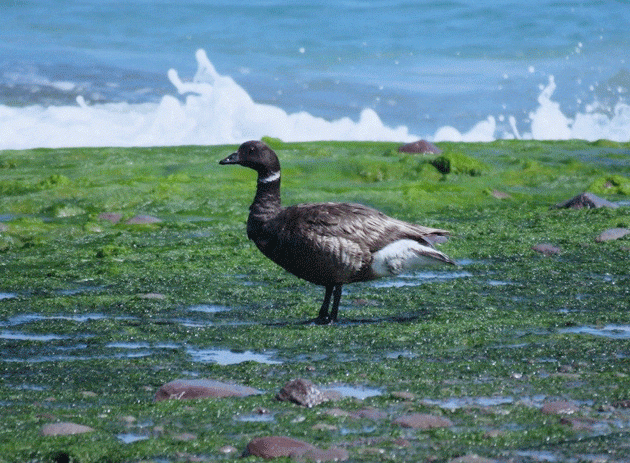
by Karen Telleen-Lawton, Noozhawk Columnist, Read the original column at Noozhawk.com
Migrating wildlife are the incredible drones of the natural world.
On the air, land and waterways, they follow arcane instructions through complex landscapes. They face daunting natural and man-made hazards to arrive at destinations far-flung, or sometimes just a few feet away.
Some Arctic terns visit Santa Barbara Island as they migrate over 18,000 miles annually between the Arctic and the Antarctic circles.

Gray whales pass through the Channel Islands on the way south to their Baja birthing lagoons and hug the shore more closely on their return trip to the Arctic with their “whalelets.”
Tiny Scripps murrelets, absent for many years from Santa Barbara Island, were persuaded to return to ancient migrating patterns using audio recordings of other Scripps murrelets.
One of the essential factors for most migrations is light. The shortening and lengthening days serve as migration signals; the cover of night improves safety.
“Birds are frequently attracted to lighting, especially during inclement weather events during migration,” according to the Fish and Wildlife Service. “Lights can cause confusion, disorientation, and exhaustion — directly impacting their ability to migrate.”
Since 2001 the International Dark Sky Places (IDSP) Program has encouraged communities to protect dark sites through responsible lighting policies and public education. They work on research and education on the effect of artificial light on wildlife and ecosystems, energy waste, human health, and our night sky heritage.
IDSP refutes claims that night lighting deters crime. They point to a 2015 study published in the Journal of Epidemiology and Community Health that found that streetlights are costly but don’t prevent accidents or crime.
Meanwhile, the Birdcast website verifies what you may be noticing in your neighborhood. Spring migration is just cranking up.
Western Kingbirds, Lincoln’s Sparrows, Varied Thrushes, Hooded Mergansers, Pine Siskins, and many others are winging north in a focused race to breeding grounds.
On the night of March 22, 6,300 migrating birds crossed Santa Barbara County. That number will grow substantially in the coming weeks. The early birds will set off 30-45 minutes after sunset, while most will be in flight within two to three hours.
The more research focuses on the effects of the night sky, the more is revealed. A recent article in Science by Kate Wheeling contains a surprising new finding:
“Artificial lights from coastal cities, harbors, and ships infiltrate the water column, sending mixed messages to organisms that take cues from natural light signals,” Wheeling writes.
Light appears to change the nightly micro migrations of marine worms, barnacles and corals, preventing some of their larvae from finding appropriate latching places.
The study, by community ecologist Thomas Davies at the UK’s University of Exeter, found that artificial light affected marine ecosystems by driving away certain invertebrate species, like filter feeders, while attracting others.
Unfortunately, the thrivers were microorganisms, algae and invertebrates that anchor to boat hulls, jetties, and aquaculture facilities. Barnacles proliferate in harbor light: their removal is estimated to cost more than $303 million annually.
Birds, whales, and the micro-migrators of the world serve us in many ways. They are filterers, pollinators, scavengers, seed dispersers, erosion control engineers, decomposers, climate regulators, and carbon storers. They also act as benchmarks for environmental health, increase livability, and connect people to the natural world.
Migration habits are diverse, but the answers for preserving night migration are generally similar for all wildlife.
1. Minimize our impact. As your mother always told you, turn off the lights. Dim non-essential lighting, especially during critical migration periods. Encourage businesses and governments to use LEDs emitting less harmful spectrums of light.
2. Maximize the percentage of land, water, and air returned to the wild, including the night sky. Allow creatures to migrate freely, for their own benefit and so they can work their magic on keeping the earth habitable.
I can’t close without addressing the question I posed in my bird column last fall: Where does migrating bird poop go?
According to Laura Erickson, science editor at the Cornell Laboratory of Ornithology, “Geese … are less likely to defecate when they are flying than when they are grazing and walking on the ground. They tend to empty their cloacas upon takeoff, cutting down on the risk to bystanders.”
If you’re birdwatching something other than geese, I recommend keeping your mouth closed.

Karen Telleen-Lawton, Noozhawk Columnist
Karen Telleen-Lawton is an eco-writer, sharing information and insights about economics and ecology, finances and the environment. Having recently retired from financial planning and advising, she spends more time exploring the outdoors — and reading and writing about it. The opinions expressed are her own.

